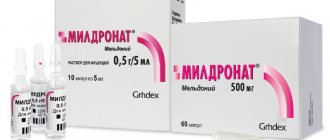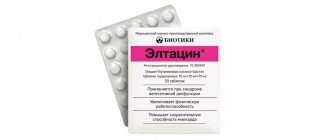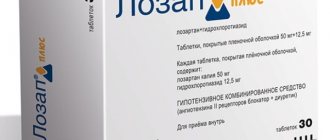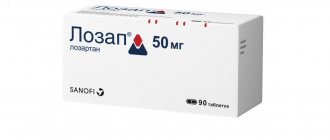Updated: 04/23/2021 15:13:42
Expert: Abramova Tsilya
Cardionate and Mildronate are analogues, but have some distinctive properties. We analyzed the similarities and differences between the drugs to determine which is better and in which situations.
| Medicine | Advantages | Flaws |
| Cardionate | Does not cause severe symptoms if the dosage is exceeded; Has a more positive effect on the cardiovascular system | Available only in capsules and solution |
| Mildronate _ | Low toxicity, no cases of overdose have been recorded; More release forms; Helps better cope with psycho-emotional and physical stress | More possible unwanted symptoms; Higher cost |
Medicine for life?
One of the medicinal substances actively used to maintain health is meldonium. It is part of a group of metabolic elements that actively work in energy metabolism processes at the cellular level. The pharmaceutical industry of different countries has developed and produced a huge number of drugs using this substance as the main active component. Frequently asked questions about two of them: Cardionate or Mildronate - which is better? Feedback from doctors and patients, as well as a comparative analysis, will allow you to answer it as accurately as possible.
History of discovery
The substance meldonium has a very interesting path into the pharmaceutical industry and is in demand on the drug market. It was originally obtained synthetically as a result of searching for the problem of rocket fuel disposal. This happened in the 1970s in the Latvian SSR at the Institute of Organic Synthesis at the Academy of Sciences. First, meldonium began to be used in plant growing to stimulate growth, then its ability to act as a cardioprotector in animals was discovered. It was then that the decision was made to conduct the necessary research and testing so that meldonium would be among the medicinal substances. Today it is widely used both in clinical medicine and in sports. Meldonium is included in the List of vital and essential drugs, which is approved by the Russian Government. This substance is included in many medications, for example, Mildronate and Cardionate. Comparing these drugs will ensure that they are similar.
In what form are medications containing meldonium available?
For many patients who are prescribed a drug with meldonium, the question arises: “Mildronat”, “Cardionate” - is there a difference between them? Let's consider these drugs from the point of view of release form. The drug "Mildronat" has three dosage forms:
- gelatin capsules containing 250 or 500 mg of meldonium;
- tablets 500 mg of active substance;
- injection solution, 1 ml of which contains 100 mg of the active ingredient.
Two forms of release are registered for the drug "Cardionat":
- gelatin capsules containing either 250 mg or 500 mg of meldonium;
- solution for injection in 5 ml ampoules containing 500 mg of active substance.
Answer the question by considering the release forms of the drugs: “Cardionat” or “Mildronat” - which is better? - it’s impossible, since they are produced in the same form with the same amount of active ingredient.
Release form. Compound. Manufacturer
Both drugs are produced on the basis of one active ingredient - meldonium and are almost identical. However, medicines differ in their manufacturer and release form.
Mildronate is produced by Latvian in the form of capsules and syrup intended for oral administration. It is also produced as a solution for administering the drug intramuscularly, intravenously and parabulbarly.
Cardionate is a Russian analogue of Mildronate, produced by pharmaceutical companies and MAKIZ-PHARMA in the form of capsules and as an injection solution.
About Cardionate
The drug "Cardionat" is produced in Russia, located in Moscow. The company is engaged in the development and production of finished dosage forms. The product line includes 43 items, including the drug with meldonium “Cardionat”. It is available in two medicinal forms - in capsules and as an injection solution, and in both forms it is the only active component. The remaining substances present in drugs play a formative role. For capsules it is:
- colloidal silicon dioxide;
- calcium stearate;
- potato starch.
In addition to meldonium, the ampoules contain water for injection in the amount necessary to concentrate the solution.
About "Mildronat"
The medicinal substance with meldonium under the brand name “Mildronat” is produced by the pharmaceutical company (AS Grindeks), which unites five enterprises from Latvia, Slovakia, Russia, and Estonia. It was in Latvia that the substance meldonium was patented in 1992. The Grindeks association is engaged in the development, production and sale of both dosage forms and individual substances used in pharmaceuticals, in the production of cosmetics, and sports nutrition. One of these substances is meldonium. The drug "Mildronat", which is produced in three dosage forms, contains the only working substance - meldonium. All other components included in the structure of drugs are formative substances:
- the capsule shell consists of titanium dioxide (white coloring matter), gelatin, calcium stearate, potato starch, colloidal silicon dioxide;
- tablet form consists of silicon dioxide, potato starch, mannitol, povidone, magnesium stearate, microcrystalline cellulose;
- the injection solution is based on special water, taken in the amount necessary to obtain the percentage of the medicinal substance in 1 ml of solution.
Considering the dosage forms and composition of the active component and excipients, we can conclude that Cardionat and Mildronate are the same medicine from different manufacturers.
Comparison of Cardionate and Mildronate
The drugs have almost the same effect. There is a difference between them, but not significant.
Similarities
Cardionate and Mildronate have the same characteristics:
- the main active ingredient is meldonium;
- are available in the form of capsules and solutions for injection;
- identical dosage;
- bioavailability - 78%;
- have the same contraindications, restrictions and method of use;
- both drugs are excreted by the kidneys.
What is the difference
Cardionate is produced in Russia, and Mildronate is produced in Latvia. They have a slight difference in composition and indications for use.
Which is cheaper?
Cost of Cardionat: capsules - 190 rubles. (40 pcs.), ampoules for injections - 270 rubles.
Mildronate is much more expensive. The price of capsules is 330 rubles. (40 pcs.) and 620 rub. (60 pcs.). Ampoules cost 380 rubles.
How does the active substance work?
Meldonium is a metabolic substance that responds and actively participates in energy metabolic processes occurring in the cells of living organisms. Balance is the basis of life, and balance at the cellular level is the basis of health. In some conditions, the active work of carnitine, which serves as a conductor of long-chain fats into the mitochondria of cells for their breakdown and energy production, should be reduced, since the fats do not have time to be broken down and accumulate in the form of unoxidized fatty acids of active forms.
The process of proper healthy oxidation takes place with the participation of oxygen, but during certain diseases and pathological conditions there is a lack of oxygen and a slowdown in the oxidation of fats to biologically digestible structures. Meldonium blocks carnitine, preventing fats from entering the mitochondria without sufficient oxygen.
This substance has the following functional abilities based on improving metabolic processes by activating the supply of oxygen to cells:
- antianginal;
- antihypoxic;
- angioprotective;
- cardioprotective.
The bioavailability of meldonium in various pharmaceutical forms is about 80%. It is quickly absorbed from the gastrointestinal tract, and reaches peak concentration in the patient’s blood within 1.5-2 hours. This substance is then metabolized in the liver to non-toxic components, which are excreted in the urine.
In what cases is the use of drugs with meldonium indicated?
Since the active substance meldonium is included in the preparations Cardionat or Mildronate, their indications for use will be the same. They are used in the treatment of such diseases and conditions:
- alcohol withdrawal;
- peripheral arterial disease;
- bronchial asthma;
- encephalopathy;
- stroke;
- cardiac ischemia;
- cardialgia with myocardiopathy;
- retinal hemorrhages;
- occlusion of the central retinal vein or its branches;
- acute disturbance of the blood supply to the retina;
- postoperative period;
- retinopathy of various etiologies;
- chronic heart failure;
- reduced performance;
- thrombosis of the central and peripheral retinal veins;
- physical overload (including sports);
- chronic obstructive pulmonary disease;
- cerebrovascular insufficiency.
When prescribing this drug, all basic methods of treating diseases are preserved. The drug can be used both as the main and as an auxiliary component.
Metabolic drugs
Such drugs refer to drugs that stimulate metabolic processes in the body. There is no generally accepted classification of them, therefore each individually has a unique mechanism of action and indications for use.
Cardionate and Mildronate are metabolic drugs containing meldonium . Its main function is to increase performance and reduce physical and mental stress. Medicines are practically analogues. However, there are some differences between them that will affect your choice of one over the other. Which one is better? And which one to take when?
Are there any contraindications?
If necessary, the doctor prescribes the drugs Cardionat or Mildronate. They contain the same active substance - meldonium. Contraindications to the use of these drugs will be the same:
- individual high sensitivity to meldonium or to the auxiliary components of the drug;
- intracranial hypertension resulting from intracranial tumors or impaired venous outflow.
The use of drugs with meldonium is not recommended for children under 18 years of age, as well as for pregnant and breastfeeding women. This ban is due to the lack of knowledge of the effect of the active substance on the body of a child or fetus. Extreme caution and constant monitoring of health requires taking meldonium preparations for pathologies of the liver and/or kidneys.
What about the side effects?
When deciding whether Cardionate or Mildronate is better, for many patients one of the factors is the potential for side effects. But since both drugs are drugs with meldonium and do not contain other active components, their manifestation will be the same. Side effects when using these medications may include:
- rashes on the skin;
- hyperemia;
- hypotension;
- itching;
- heartburn;
- edema;
- belching;
- increased arousal;
- tachycardia;
- nausea.
Side effects of drugs containing meldonium are extremely rare.
What and when to take?
the doctor should prescribe which one and when to take it .
Some specialists observed some differences in the therapeutic effect during practice. For example, it was noted that Mildronate quickly helps to cope with the consequences of increased physical or mental stress, and Cardionate has a positive effect on the functioning of the heart.
The choice of one of the drugs is influenced by the cost: Cardionate is, of course, more affordable in this regard.
There is no consensus among doctors about which drug is better, and they often leave the right to choose to the patient.
Cardionate and Mildronate are effective medications, but you should not use them without a doctor’s prescription. Often, due to heavy work or study load, people decide to take metabolic medications on their own, without knowing the cause of their true illness. Therefore, it is better to conduct an examination before using such drugs so as not to cause harm to the body.
If you find an error, please select a piece of text and press Ctrl+Enter.
Meldonium and sporting achievements
Until recently, one could hear a debate about “Cardionate” or “Mildronate” - which is better for sports? Meldonium increases the endurance of athletes, allowing them to recover faster after active training and performances in competitions. The World Anti-Doping Agency (WADA) has included this substance in the list of prohibited substances for use by athletes. The Meldonium scandal with Russian athletes has caused significant harm to the prestige of our sport. Today, the question of whether Cardionate or Mildronate is better is debated only in clinical medicine and behind the scenes of sports.
Features of the use of drugs with meldonium
Only a doctor can prescribe the use of drugs with meldonium according to the available indications. He will choose the form of the medicine and the mode of application. Patients should take into account some features of the use of both Cardionate and Mildronate:
- It is best to take the medicine in the first half of the day, so that as a result of the development of increased arousal, as a side effect, it does not spoil the night’s sleep;
- when administering the drug intramuscularly, quite severe pain may be felt at the injection site, so administering the drug intravenously is preferable;
- in the treatment of retinopathy, drugs with meldonium are administered only parabulbarly (in the area of the lower eyelid under the skin or to a depth of 1 centimeter), this is a very painful injection;
- It is not recommended to take alcohol during treatment with drugs containing meldonium due to a possible decrease in the quality of treatment and the development of adverse reactions in the body.
The doctor must take into account the interaction of drugs, as well as the patient’s condition and the course of the disease. Meldonium potentiates the activity of drugs with coronary action, antihypertensive drugs, as well as drugs that promote dilation of peripheral blood vessels. The combined use of such drugs may cause tachycardia and low blood pressure.
Material and methods
The open study included 119 patients with ischemic stroke (IS) and CCI (in Russian terminology DE), who received care during the period from February 1 to December 31, 2011. The age of the patients varied: with IS - from 29 to 82 years (average - 63.4 years), with DE - from 42 to 85 years (average - 57.7 years). The main vascular disease in the examined patients was hypertension. The duration of increased blood pressure in patients with IS was on average 12.7 years, in patients with DE - 11.9 years.
The patients were divided into two groups. Group 1 consisted of 32 patients with IS (15 men and 17 women). Group 2 consisted of 87 patients with DE (21 men and 66 women).
The criteria for inclusion of patients in the study were: for IS - the presence of a CT-verified stroke at the hospital stage and/or a stroke diagnosed by a neurologist upon discharge from the hospital; for DE – absence of severe cognitive impairment.
Exclusion criteria: for IS - patients staying in hospital for a short period (up to 7 days) and refusal of further treatment; transient ischemic attacks (TIA), the presence of space-occupying brain lesions confirmed by instrumental examination methods, encephalopathy; for DE - the presence of decompensated somatic pathology, severe dementia, Alzheimer's disease, Parkinson's disease, and mental disorders.
65 patients were diagnosed with DE without previous strokes and 22 patients with a history of IS. In case of CCI, the symptom complex was represented by both subjective and objective manifestations of the disease, when 2 or more characteristic symptoms were often repeated and/or existed for at least the last 3 months.
Written consent was obtained from each patient for examination and treatment.
To conduct the study, a protocol was developed that included obtaining information from the anamnesis about the patients’ complaints, objective symptoms, blood pressure (usual for the patient, “office” and after 15 minutes; measured twice using the Korotkoff method on the brachial artery, after which the values of SBP and DBP were recorded) , Heart rate (usual for the patient, during the initial examination and after 15 minutes). Additional examination methods included standard ECG, glucose monitoring (especially for diabetes mellitus), information on taking medications prescribed by the local doctor, subjective data on the condition of patients after treatment (patient complaints), clinical symptoms after treatment and a doctor’s report (indicating side effects , if any), diagnosis (including concomitant pathology). Data from patients in groups 1 and 2 were entered into an identical protocol and then included in the database of the AFIS computer program.
When analyzing the most important risk factors for stroke and DE, special attention was paid to hypertension, ischemic heart disease and diabetes mellitus (DM).
Mildronate was administered intravenously slowly at a dose of 1000 mg (10 ml of 10% solution), diluted in saline. If before the administration of mildronate during IS the SBP was above 200 mm Hg. and/or DBP above 110 mm Hg, and with DE - SBP above 180 mm Hg. and/or DBP above 100 mm Hg, antihypertensive drugs were used (after administration of mildronate). The patient with IS was monitored until he was transferred to the hospital neurologist.
To assess the safety of mildronate, in both groups 1 and 2, all undesirable effects were recorded based on patient complaints and targeted questioning.
All patients with DE (group 2) underwent outpatient treatment. In this case, repeated calls to patients were monitored within 10 days from the date of the initial examination (especially in the first 7 days).
Patients of group 1 (II) were hospitalized in city hospital No. 1. The examination of these patients was carried out at the hospital stage. It consisted of assessing subjective data, neurological deficit, blood pressure upon admission, verification of stroke using CT, ultrasound diagnostics of blood vessels in the brain and neck, determination of glucose and total cholesterol in the blood. The number of hospital days spent, the condition upon discharge from the hospital, the number of discharged patients, deaths, and the number of patients sent for follow-up treatment to an outpatient clinic were also taken into account.
In addition, an analysis of objective symptoms was carried out during the initial examination (by a doctor at an emergency medical service station) and upon admission to the hospital (by a neurologist) with an assessment of the neurological status (analysis of the quality of diagnosis by doctors at an emergency medical service station).
The results of treatment effectiveness were based on subjective data (headache, dizziness, noise in the head, poor memory, emotional lability) and assessment of neurological deficits (motor, vestibulo-cerebellar, sensory and speech disorders). The treatment effect was assessed by the doctor and the patient in both groups as: “improvement” and/or “no change”.
Statistical analysis was carried out using the protocol on the use of mildronate at the prehospital stage, the call card (form 110/y) and the medical history at the hospital stage (form 003/y).
Computer statistical processing of the results was carried out in the automated AFIS system.
Reviews from doctors and patients about the drugs
Preparations containing meldonium, produced in the same dosage forms, cannot differ significantly from one another. The doctor decides which remedy to choose for use. The only difference between these two medicines is the price - Russian meldonium is much cheaper than its Latvian analogue. For a package of Cardionat capsules you should pay about 220-270 rubles, while a similar package of Mildronate will cost the buyer almost 3.5 times more - about 800 rubles.
Which method is preferred is determined by the patient’s financial capabilities. It is difficult to choose which of the remedies is more effective - Cardionat or Mildronate. Reviews left by both doctors and patients are mostly advisory in nature. The product helps to cope well with many health problems if taken as prescribed by a doctor and in compliance with the dosage regimen.
To answer the question often asked to pharmacists in pharmacies: “Cardionat” or “Mildronat”, which is better?” - almost impossible. These are absolutely similar drugs that have the same composition, which means that the indications and contraindications for use, and potential side effects will also be the same. Only the price of the drugs will help you decide which product to purchase.
Reviews
Evgeniy, 24 years old, Kursk, student I can’t be called a professional athlete, but morning jogging and going to the gym 3 times a week help me maintain good physical shape. I took Mildronate constantly, and in different forms: I drank capsules and took injections. A good remedy. Allows you not to feel tired after quite serious loads and study normally at the university. I have little faith in the doping properties of Mildronate and scandals in the “world of sports” could not change my opinion about the drug.
Svetlana Igorevna, 42 years old, Belgorod, doctor I like meldonium-based drugs. With a minimum of side effects, maximum results are achieved. The drugs have proven themselves well in the treatment of cardiovascular diseases, chronic alcoholism, for increasing physical activity, and reducing the rehabilitation period after illness. I especially recommend it to elderly patients who literally “come to life” after a course of treatment. Cardionate or Mildronate – I always leave the choice to the patients, because their effects are identical. Judging by their price, it is quite high, but Cardionat is still a little cheaper.
Svetlana, 16 years old, school graduate, Pskov The last years of school were difficult for me. A large number of lessons, homework, difficult-to-learn material. In general, the loads are solid. I just lost my strength: I can’t wake up in the morning, I’m sleepy all day, I don’t perceive information. The therapist prescribed Mildronate injections. One injection a day in a reduced dosage for two weeks gave me strength for further training. Now I’m preparing to enter college, full of strength and energy.
Svetlana Ivanovna, 58 years old, pensioner, Tver I don’t wish anyone to know what angina is. Systematic pressing pain in the chest sometimes causes incredible agony. The cardiologist prescribed Cardionat. Twice a day, 250 mg for the first 4 days of treatment, followed by a transition to twice a week for a month, allowed me to significantly reduce the number and intensity of attacks. Thanks to the doctor and Cardionat.
To restore cellular balance, medications are used that contain the active component meldonium, which has gained success in sports and clinical medicine. Meldonium is the main ingredient in many drugs and the first assistant in restoring metabolism. But here the question arises: which analogue is better?
Today we will try to find out which of the two drugs is worth purchasing Cardionate or Mildronate.









